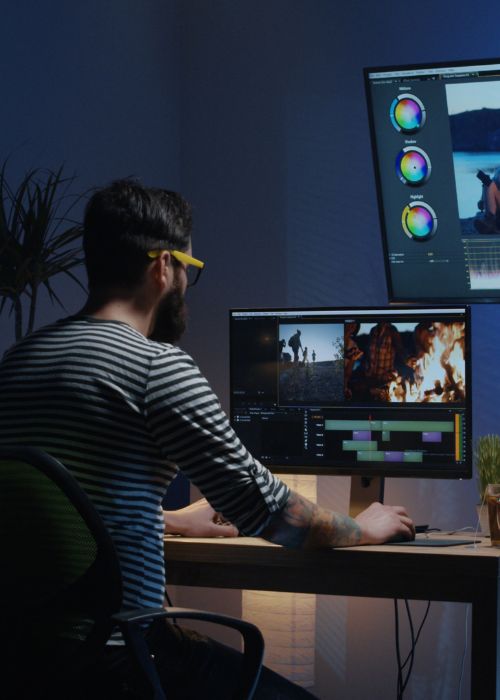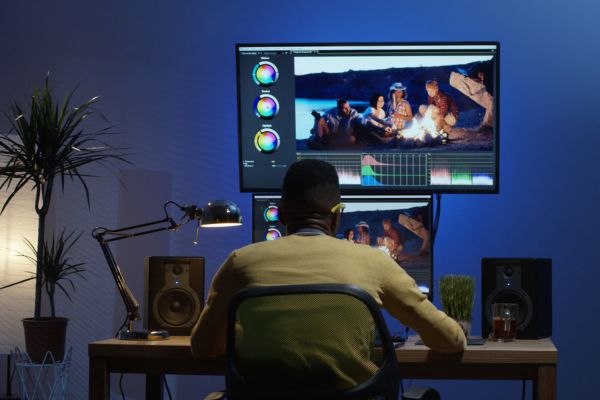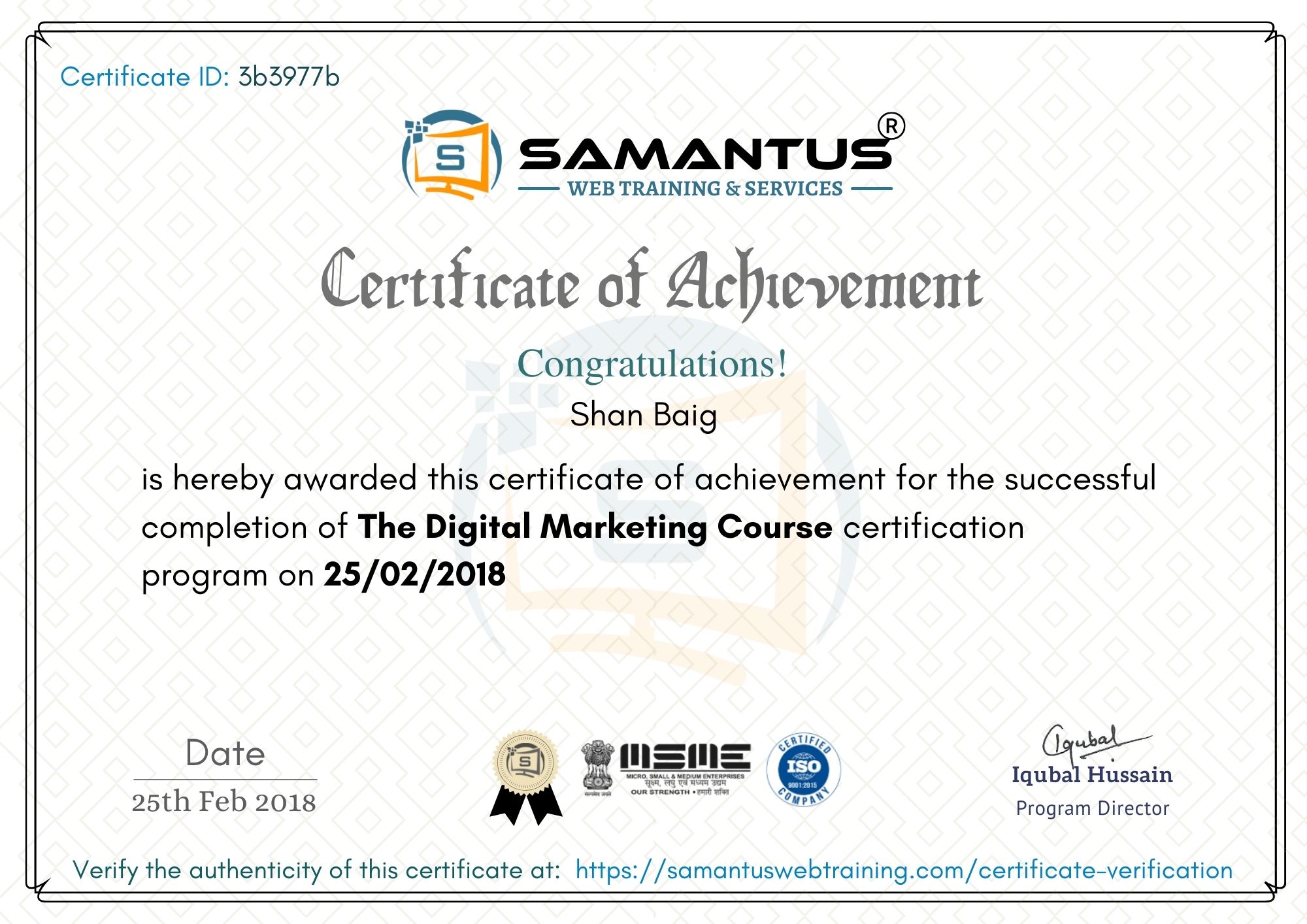A Complete Guide to Video Editing Course in Kerala
A Whole Guide to Video Editing Course : Learn skills that are in demand and become equipped for work in Kerala.

What you'll learn
In “A Whole Guide to Video Editing Course,” learn basic and intermediate video editing to generate interesting videos. Learn to edit diverse projects creatively and accurately using industry-standard tools.
Whats Material Includes?
- Introduction to Video Editing Concepts:
- Adobe Premiere Pro
- Adobe After Effects
- DaVinci Resolve – Visual Effects, Motion Graphics, Color Correction, Color Grading, Etc.
- OBS Studio
- InVideo/Camtasia/Canva (Any One)
- VideoScribe/Any White Board Animation

Complete a Video Editing Course with Samantus
- Live Project
- 95% Practical
- 100% Placement help

Get a Certificate in Video Editing Course in Kerala
Unlock Your Potential: Get Your Video Editing Course Certificate Today

Award winning

Make your Career
Course Curriculum (Basic to Advanced):
1: Introduction to Video Editing Concepts:
Module 1: Understanding Video Editing
- An overview of video editing and its importance in filmmaking and multimedia production
- Introduction to key concepts: footage, timeline, editing software, and workflow
Module 2: Video Formats and Codecs
- I am understanding video file formats and codecs: MP4, MOV, AVI, etc.
- Exploring compression techniques and their impact on video quality and file size
Module 3: Basic Editing Tools and Techniques
- Introduction to the editing software interface: timeline, playback controls, and editing tools.
- Basic editing techniques: cutting, trimming, splitting, and arranging clips on the timeline
Module 4: Transitions and Effects
- Adding transitions between clips: cuts, fades, wipes, and dissolves
- Applying visual effects (color correction, filters, and overlays) to enhance footage
Module 5: Audio Editing and Mixing
- Understanding audio tracks: voiceovers, music, and sound effects
- Adjusting audio levels, applying fades, and synchronizing audio with video
Module 6: Titles and Graphics
- Creating and adding text titles, lower thirds, and captions to videos
- Incorporating graphics and logos into video projects
Module 7: Keyframing and Animation
- Introduction to Keyframing: Creating Motion and Animation Effects
- Using keyframes to animate properties like scale, position, and opacity
Module 8: Exporting and Publishing
- I am exporting video projects in various formats: MP4, MOV, WMV, etc.
- Optimizing video settings for different platforms: social media, web, and broadcast
Module 9: Project-Based Learning
- I am applying my video editing skills to real-world projects: creating short films, promotional videos, vlogs, etc.
- To reinforce learning and demonstrate proficiency, complete hands-on exercises and projects.
2: Adobe Premiere Pro
Module 1: Introduction to Adobe Premiere Pro
- Overview of Adobe Premiere Pro as a professional video editing software
- Understanding the interface: workspace layout, panels, and tools
Module 2: Importing and Organizing Media
- Importing media files: video clips, audio tracks, images, and graphics
- Organizing media assets in the project panel: bins, folders, and metadata
Module 3: Basic Editing Techniques
- Understanding the timeline: tracks, clips, and sequences
- Basic editing techniques: cutting, trimming, splitting, and rearranging clips
Module 4: Transitions and Effects
- Adding transitions between clips: cuts, fades, wipes, and dissolves
- Applying visual effects (color correction, filters, and overlays) to enhance footage
Module 5: Audio Editing and Mixing
- Adjusting audio levels, applying fades, and adding sound effects
- Integrating music tracks and voiceovers into video clips
Module 6: Titles and Graphics
- Creating and customizing text titles, lower thirds, and captions
- Incorporating graphics, logos, and animations into video projects
Module 7: Advanced Editing Techniques
- Using advanced editing tools: ripple edit, slip slide, and time remapping
- Keyframing and animation are used to create dynamic effects.
Module 8: Multi-camera editing
- Working with multi-camera sequences: syncing, switching, and editing footage from multiple cameras
- Streamlining the multi-camera editing process to ensure an efficient workflow
Module 9: Color Grading and Correction
- Understanding color correction vs. color grading
- Applying color adjustments, LUTs, and creative looks to enhance visual storytelling
Module 10: Exporting and Publishing
- I am exporting video projects in various formats: MP4, MOV, WMV, etc.
- Optimizing video settings for different platforms: social media, web, and broadcast
Module 11: Collaboration and Workflow Optimization
- Collaborating with team members via Adobe Creative Cloud integration
- Implementing workflow optimizations and best practices for efficient editing.
Module 12: Project-Based Learning
- I am applying my Adobe Premiere Pro skills to real-world projects: short films, documentaries, promotional videos, etc.
- To reinforce learning and demonstrate proficiency, complete hands-on exercises and projects.
3: Adobe After Effects
Module 1: Introduction to Adobe After Effects
- Adobe After Effects is a motion graphics and visual effects software.
- Understanding the interface: workspace layout, panels, and tools
Module 2: Importing and Organizing Assets
- Importing media files: video clips, images, audio, and graphics
- Organizing assets in the project panel: folders, compositions, and asset management
Module 3: Compositing and Layering
- Understanding layers and compositions in After Effects
- Layer properties: opacity, blending modes, and transformation controls
Module 4: Animation Techniques
- Keyframe animation: creating motion and movement with keyframes
- Animation presets and expressions: automating animation tasks and adding complexity to motion graphics
Module 5: Effects and Presets
- Applying visual effects and presets: transitions, text animations, and motion graphics templates
- We are customizing effect parameters and creating custom effects.
Module 6: Masking and Rotoscoping
- Masks can be used to isolate and manipulate specific areas of a composition.
- Rotoscoping techniques: tracing and animating objects or subjects within video footage
Module 7: Motion Tracking
- Fundamentals of motion tracking: tracking points, tracking data, and tracking methods.
- Motion tracking data is used to stabilize footage or add visual effects.
Module 8: 3D Animation and Camera Tools
- Creating 3D layers and animations within After Effects
- Working with cameras: creating camera movements and animations in 3D space
Module 9: Green Screen and Chroma Keying
- Using green screen and chroma keying techniques, remove backgrounds.
- Integrating keyed footage with other elements in the composition
Module 10: Advanced Techniques and Workflow Optimization
- Puppet tools, shape layers, and text animators are examples of advanced animation techniques.
- Workflow optimizations and best practices for efficient motion graphics production
Module 11: Rendering and Exporting
- Rendering settings and options: resolution, frame rate, and output formats
- Exporting compositions for various platforms: web, social media, broadcast, and film
Module 12: Project-Based Learning
- I am applying my Adobe After Effects skills to real-world projects: motion graphics animations, visual effects composition, title sequences, etc.
- To reinforce learning and demonstrate proficiency, complete hands-on exercises and projects.
4: DaVinci Resolve – Visual Effects, Motion Graphics, Color Correction, Color Grading, Etc.
Module 1: Introduction to DaVinci Resolve
- Overview of DaVinci Resolve as an all-in-one post-production software
- Understanding the interface: workspace layout, panels, and tools
Module 2: Importing and Organizing Media
- Importing media files: video clips, images, audio, and graphics
- Organizing assets in the media pool: bins, folders, and metadata
Module 3: Basic Editing Techniques
- An introduction to the cut, edit, and trim tools for assembling video clips
- Applying transitions and effects to improve the edit’s visual flow
Module 4: Color Correction and Grading
- Understanding color correction vs. color grading
- Using color wheels, curves, and scopes to make precise color adjustments
Module 5: Visual Effects and Motion Graphics
- Exploring Fusion, DaVinci Resolve’s built-in visual effects and motion graphics tool
- Creating motion graphics, animations, titles, and lower thirds
Module 6: Audio Editing and Mixing
- Adjusting audio levels, adding sound effects, and integrating music tracks
- Using Fairlight, DaVinci Resolve’s audio editing and mixing tool
Module 7: Advanced Color Grading Techniques
- Applying secondary color corrections and power windows for targeted adjustments
- Using LUTs (look-up tables) and film grain emulation to achieve creative looks
Module 8: Keying and Chroma Keying
- Using the keying and chroma keying tools, remove backgrounds.
- Integrating keyed footage with other elements in the composition
Module 9: Fusion for Visual Effects
- Advanced visual effects techniques: composing, tracking, and rotoscoping
- Creating complex visual effects shots using Fusion’s node-based workflow
Module 10: Delivering and Exporting
- Exporting projects for various delivery formats: web, social media, broadcast, and film
- Optimizing render settings for maximum quality and efficiency.
Module 11: Workflow Optimization and Collaboration
- Workflow optimizations and best practices for efficient post-production
- Using DaVinci Resolve’s collaborative features, collaborate with team members.
Module 12: Project-Based Learning
- Applying DaVinci Resolve skills for real-world projects: short films, commercials, music videos, etc.
- To reinforce learning and demonstrate proficiency, complete hands-on exercises and projects.
5: OBS Studio:
Module 1: Introduction to OBS Studio
- Overview of OBS Studio as an open-source software for live streaming and recording
- Understanding the interface: scenes, sources, and settings
Module 2: Setting Up OBS Studio
- Installing OBS Studio and configuring basic settings
- Understanding streaming platforms and setting up streaming profiles
Module 3: Scenes and Sources
- Creating and managing scenes: Layouts for various broadcast scenarios
- Adding and configuring sources: webcam, display capture, image, text, and media files
Module 4: Recording and Streaming
- Configuring recording settings: resolution, frame rate, and audio sources
- Setting up streaming settings (bitrate, encoder, and streaming platform integration)
Module 5: Transitions and Effects
- Using transitions to switch between scenes smoothly
- Applying filters and effects: color correction, chroma key, and image overlays
Module 6: Audio Management
- Managing audio sources: desktop audio, microphones, and auxiliary devices
- Adjusting audio levels and configuring audio filters
Module 7: Scene Switching and Hotkeys
- Assigning hotkeys for quick scene switching and source control
- Optimizing workflows with custom hotkey configurations
Module 8: Advanced Settings and Plugins
- Exploring advanced settings: video output, recording formats, and encoder options
- Installing and configuring plugins for additional functionality
Module 9: Multi-Platform Streaming
- Simultaneously streaming to multiple platforms using OBS Studio
- Integrating chat overlays and alerts for interactive streaming experiences
Module 10: Project-Based Learning
- Applying OBS Studio skills to real-world streaming projects: gaming streams, tutorials, podcasts, and more
- To reinforce learning and demonstrate proficiency, complete hands-on exercises and projects.
6: InVideo/Camtasia/Canva (Any One):
Module 1: Introduction to Canva
- Overview of Canva as a graphic design platform for creating visual content
- Understanding the interface: dashboard, design types, and templates
Module 2: Creating Designs
- We are exploring various design types such as social media posts, presentations, posters, flyers, among others.
- Using templates and layouts to kickstart design projects
Module 3: Working with Elements
- Adding and customizing elements: images, icons, shapes, and illustrations
- Using the search and filter options to find relevant design assets
Module 4: Text and Typography
- Adding text to designs (headlines, body text, and captions)
- Formatting and styling text: font styles, sizes, colors, and effects
Module 5: Colors and Backgrounds
- Applying color schemes and gradients to designs
- Adding background images and patterns to enhance the visual appeal
Module 6: Collaboration and Sharing
- Collaborating with team members: sharing designs, commenting, and reviewing
- exporting designs in various formats: JPEG, PNG, PDF, etc.
Module 7: Branding and Customization
- Creating and managing brand kits: adding brand colors, fonts, and logos
- Customizing designs to reflect brand identity and style guidelines
Module 8: Animation and Motion Graphics (Canva Pro)
- Creating animated designs and motion graphics using Canva Pro features
- Adding animations and transitions to enhance visual storytelling
Module 9: Advanced Design Techniques (Canva Pro)
- Exploring advanced design tools and features: Magic Resize, Background Remover, and more
- Using advanced techniques to create professional-quality designs
Module 10: Project-Based Learning
- Canva skills in real-world design projects: social media graphics, presentations, marketing materials, etc.
- To reinforce learning and demonstrate proficiency, complete hands-on exercises and projects.
7: VideoScribe/Any White Board Animation:
Module 1: Introduction to VideoScribe
- VideoScribe, a whiteboard animation software for creating engaging videos, is explained.
- Understanding the interface: canvas, tools, and library
Module 2: Getting Started with VideoScribe
- I am setting up a new project and configuring canvas settings.
- Importing and organizing assets: images, text, and audio
Module 3: Creating Whiteboard Animations
- Adding and customizing elements: hands, pens, images, and text
- Using the timeline to animate elements and control timing
Module 4: Text and Typography
- Adding text to whiteboard animations: titles, captions, and bullet points
- Applying text effects and animations to enhance visual appeal
Module 5: Drawing and Hand Animation
- Using the drawing tool, create hand-drawn animations.
- Customizing hand styles and animations for a personalized touch
Module 6: Adding Music and Voiceovers
- Importing audio files: background music, voiceovers, and sound effects
- Syncing audio with animations for a cohesive viewing experience
Module 7: Exporting and Sharing
- Exporting whiteboard animations in various formats: video, GIF, and image sequence
- Sharing animations on social media, websites, and video platforms
Module 8: Advanced Techniques and Tips
- Exploring advanced animation techniques: morphing, path animation, and camera movements
- Tips and tricks for optimizing workflow and creating professional-quality animations
Module 9: Project-Based Learning
- VideoScribe skills to real-world projects: explainer videos, educational content, marketing materials, etc.
- To reinforce learning and demonstrate proficiency, complete hands-on exercises and projects.
Companies That Hire
(Freshers & Experienced Required As Per Company Norms)










